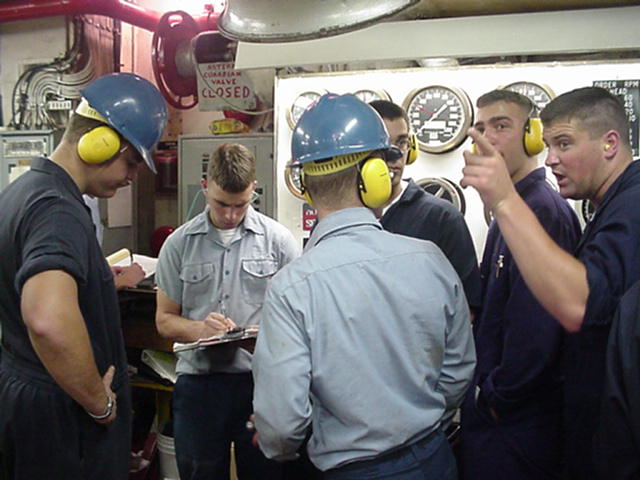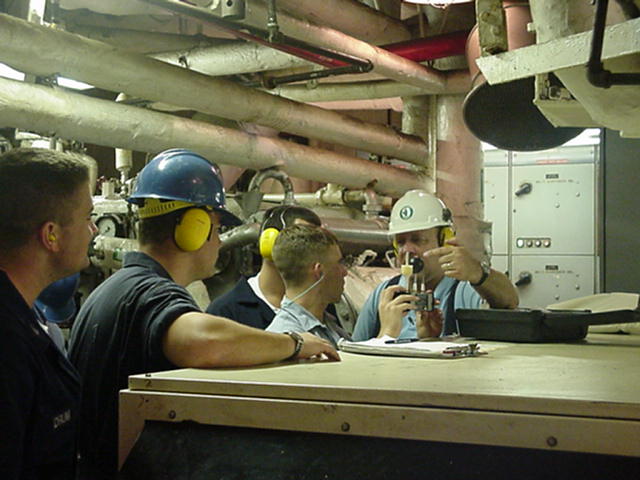
| February 2001 | ||||||
| Sun | Mon | Tue | Wed | Thu | Fri | Sat |
| 1 | 2 | 3 | ||||
| 4 | 5 | 6 | 7 | 8 | 9 | 10 |
| 11 | 12 | 13 | 14 | 15 | 16 | 17 |
| 18 | 19 | 20 | 21 | 22 | 23 | 24 |
| 25 | 26 | 27 | 28 | |||
At 0800 Atlantic Standard Time, the Training Ship Empire State was located at 18 degrees and 09 minutes N Latitude, 64 degrees and 47 minutes W Longitude and steering various courses and speeds into the harbor at St. Thomas, U.S. Virgin Islands. The weather was very nice; air temperature 80 degrees and water temperature 78 degrees Fahrenheit; skies were mostly cloudy; winds were from the East at 11 knots; barometric pressure was 1019 millibars and relative humidity was 66 percent.
CAPTAIN'S LOG
Few are too young, and none are too old, to make the attempt to learn. Booker T. Washington
The U. S. Navy pulled rank and we lost our chance at the dock here. Instead, we are anchored in the inner harbor of Charlotte Amalie, St. Thomas, the capital city of the U.S. Virgin Islands. But that did not diminish the excitement of arrival.
Not because we were heading into port after four (long?) days at sea, no, we were excited because our pilots were graduates of MMA! Eric Robinson and Robert Ripley, class of 1993, have been pilots here since 1997 and 1998. They were instrumental in arranging our inside harbor anchorage, only .25 miles from Veterans Drive in Charlotte Amalie.
Kind of cool bringing her in here, practically pushing the smaller boats - mainly cruising sailboats - out of the way to make room for this big old ship. We are anchored using two anchors, unusual, but a good lesson for the cadets. Now, one and a half hours after anchoring, we have cleared customs and are running four motor whaleboats as liberty launches. In the first hour we moved nearly one hundred officers, cadets, and crew ashore.
Our liberty parties will ferry ashore in our own boats. In keeping with the sea term motto: "If you're handed lemons... make lemonade", the deck cadets will now get the chance to step up and demonstrate their skills - just like our cadet engineers did in Curacao. I'm sure the "deckies" will excel at small boat handling skills by the time we depart this anchorage. With over 1000 personnel transfers each day as cadets and staff go ashore and return, in daylight and in darkness, this exercise goes well beyond classroom discussion. It is this practical, hands-on experience that makes our cadets so valuable at graduation.
The new TV show "Battlebots" has nothing on the TSES. The battle of humans vs. machines onboard the training ship continues. Yesterday, the air conditioning unit got into the tag-team wrestling match started by the turbo-generator in Curacao. I know that those of you reading this in New England (where it is below freezing today with a wind chill of zero) will find it difficult to empathize, but here in the tropics "no ventilation" is more than an inconvenience.
The failed AC units provide fresh, cooled air to the berthing spaces, classrooms and staterooms. Ambient temperatures in the high 80's and humidity in the high 70's, would qualify as an uncomfortable day on Cape Cod in the summer. Now, imagine being locked inside your house, unable to open any windows or doors to get ventilation. Next, add 160 of your closest friends, and shut off the water for hours at a time to conserve that precious resource. Then, have over half of the group stand watch for 4 hours out of every 8 next to the water heater and the oil burner, where the temp hovers around 100 degrees and the humidity is 100%. After a couple of days of that you have a feel for the problem that we now face. Dante's inferno would be an upgrade.
We have two manufacturer's techs onboard to work on the AC units and we have talked via cell phone, to experts from Puerto Rico, New Orleans, D.C., and New York. Our own talented engineers are on the problem and the motivation to get those big cooling fans spinning couldn't be higher. I'll keep everyone posted on round two of the constant battle to keep this sea term focused on the training plan rather than the unplanned cram courses in "Turbine Repair at Home" and now "Air Conditioning for the Hot and Harried". Meanwhile, here is a particularly appropriate report from one of the Marine Safety cadets aboard, and an engineering update from our Cadet Chief Engineer.

CADET COMMENT
Proffesor Hathaway's Marine Industrial Safety Class: Cadet 2/C Megan Kearns, Wareham,MA
One of the many MSEP classes offered on the ship is Marine and Industrial Safety, taught by Professor Hathaway. Yesterday, I sat in on a few lectures, and followed the class into the engine room. This class covers the safety and health aspects of workers aboard a ship. While I was observing, the class was covering heat loads in the engine room. In order to determine how long a person is able to work in such strenuous conditions the class uses (among others) charts from the US Army and an instrument called a heat stress analyzer. It measures factors such as radiant heat, relative humidity, ambient temperature, and wet bulb globe temperature. Using the information gathered, and the charts from the Army, the cadets figure out the amount of time that one can feasibly work in such conditions. Like many other things, the charts have stipulations. It is understood that before starting the shift, cadets are well hydrated and rested. Recommended work times also consider whether the cadets will be working constantly or if brief rest periods are to be taken along the way.
The class moved to various areas in the engine room where cadets usually work. The hottest temperature was recorded near the evaporators where the temperature rose to near 99 degrees. (the evaporators are the machines that make water for us) The charts show that cadets doing continuous light work should remain in that area for only 66 minutes and should consume at least 1.5 liters of water. If the cadets are doing moderate work in the same area, they should remain there for about 39 minutes, consuming at least 2.1 liters of water in that period of time. Basically, the class teaches our cadets how to ensure safety on the job by taking into consideration how the body works in light of the conditions around it.

Engineering Update: Cadet 2/C Megan Kearns, and Cadet 1/C Kevin Caldwell, Cadet Chief Engineer, from Gales Ferry, CT
Let us briefly update the readers on what has been happening on the ship. As you may know, the turbo generator (TG) has been repaired and we are underway to St. Thomas. The repair process involved many individuals and expended hundreds of man hours to successfully complete the work.
With the help of workers from Curacao Shipyard, our great staff and cadet engineers had the generator up and running for Monday's departure. By coincidence, there was another malfunction unrelated to the turbine repairs that kept us in Curacao for an additional day.
The overspeed trip mechanism on the same TG was worn and caused the generator to trip out on overspeed. The problem was minor. The engineers simply removed the mechanism, took it to the machine shop, and machined it to tolerance. Re-adjusting the trip points took awhile, but once those adjustments were made we were ready to go. We departed on Tuesday morning and the TG has been working fine since.
On a hotter note, we awoke this morning in a puddle of sweat. Yes, that's right folks, no AC!! Everyone is doing their best to get along with the heat throughout the house. The berthing compartments are quite unbearable, but we will make do until we anchor in St. Thomas. Sleeping arrangements for tomorrow night, when the ship is anchored, have been made. Once again, topside will resemble the refugee camp with cadets on the deck and in number two hold.